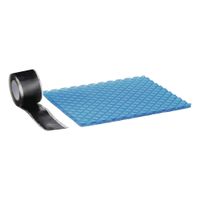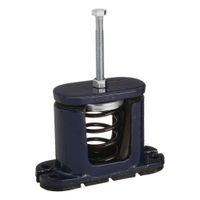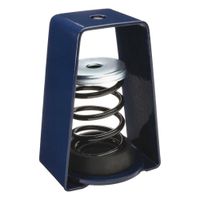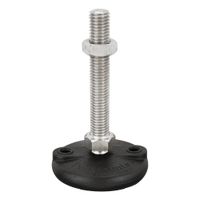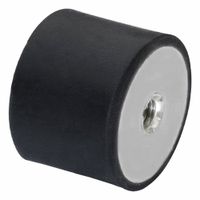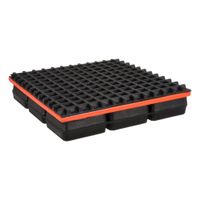Call +(254) 703 030 000 / 751 483 999 / 721 704 777
.....Read More
Frequently Asked Questions
What are vibration control and leveling mounts?
Vibration control and leveling mounts are essential components used in various industries to stabilize machinery and equipment. Their primary function is twofold: to reduce or eliminate vibrations generated by operating machinery and to provide precise leveling for optimal performance.
Vibration control is crucial because excessive vibrations can lead to several problems, including premature wear and tear of equipment, reduced operational efficiency, increased noise levels, and even structural damage to the surrounding environment. Mounts designed for vibration control typically incorporate materials like rubber, elastomers, or springs that absorb and dissipate kinetic energy, preventing it from transferring to the floor or other sensitive equipment.
Leveling, on the other hand, ensures that machinery is perfectly aligned and stable. This is particularly important for equipment that relies on precision, such as laboratory instruments, manufacturing machines, and optical devices. Leveling mounts often feature adjustable mechanisms, such as threaded studs or shims, that allow for fine-tuning of height and angle, compensating for uneven floor surfaces and ensuring the equipment operates at its intended orientation.
By effectively controlling vibrations and enabling precise leveling, these mounts contribute to improved equipment longevity, enhanced operational accuracy, reduced maintenance costs, and a safer working environment. They are widely used in sectors ranging from industrial manufacturing and automotive to healthcare and research.
How do vibration isolators work?
Vibration isolators work by decoupling an object from the source of vibration, thereby reducing the transmission of vibrational energy. Their primary function is to absorb or dissipate mechanical energy that could otherwise cause unwanted motion, noise, or damage.
There are several types of vibration isolators, each employing different principles. Passive isolators, like rubber mounts, springs, or air springs, rely on material properties to absorb energy. Rubber mounts, for instance, deform under load, converting kinetic energy into heat. Springs use their elasticity to store and release energy, effectively lengthening the natural period of vibration, which helps to move it away from the excitation frequency. Air springs achieve isolation by trapping a volume of air, whose compressibility provides a soft, cushioning effect.
Active vibration isolators, on the other hand, use sensors, actuators, and control systems to dynamically counteract vibrations. Sensors detect the vibration, and the control system sends signals to actuators (like piezoelectric devices or electromagnetic shakers) to generate opposing forces, effectively canceling out the unwanted motion.
The effectiveness of a vibration isolator depends on several factors, including the mass of the isolated object, the stiffness and damping properties of the isolator, and the frequency of the incoming vibration. Ideally, an isolator is designed to have a natural frequency significantly lower than the disturbance frequency, which allows it to filter out most of the vibrational energy.
What are the benefits of using vibration isolating pads?
Vibration isolating pads are essential components used to mitigate the transfer of unwanted vibrations from equipment to surrounding structures or vice versa. Their primary benefit lies in protecting sensitive machinery from external vibrations that could compromise their performance, accuracy, or lifespan. For example, in laboratory settings, these pads ensure that delicate instruments like microscopes or balances remain stable, preventing blurred images or inaccurate readings.
Beyond protecting equipment, these pads also reduce noise pollution. Machinery that vibrates often produces audible noise, and by absorbing these vibrations, the pads contribute to a quieter working environment, which is beneficial for employee comfort and concentration.
Furthermore, vibration isolation can extend the operational life of both the equipment and the building structure. By dampening the impact of vibrations, they reduce wear and tear on mechanical components and prevent structural fatigue in floors and foundations. This can lead to significant cost savings on maintenance and repairs over time. In applications like HVAC systems or industrial machinery, these pads are crucial for maintaining efficiency and preventing disruptive resonance within a facility.
How do hanger-mount vibration isolators differ from floor-mount isolators?
Hanger-mount and floor-mount vibration isolators serve the same fundamental purpose: to reduce the transmission of vibrations from equipment to the surrounding structure, preventing noise and potential damage. However, their design and application differ significantly based on how they support the equipment.
Hanger-mount isolators are designed for equipment suspended from overhead structures, such as ducts, pipes, or ceiling-mounted units. They typically consist of a spring or elastomeric element encased within a hanger assembly. The equipment "hangs" from these isolators, which absorb vibrations before they can travel up into the building's framework. Key characteristics include their ability to handle tension loads and their use in preventing noise from overhead mechanical systems.
Floor-mount isolators, conversely, are used for equipment resting on a floor or concrete pad, like HVAC units, pumps, or generators. These isolators are placed directly beneath the equipment's feet or base. They are designed to support compressive loads and dampen vibrations transmitted downwards into the floor slab. They come in various forms, including spring isolators, rubber pads, or neoprene mounts, each suited for different load capacities and vibration frequencies.
The primary difference lies in their installation orientation and the type of force they are designed to manage: hanger-mounts address vibrations from suspended loads (tension), while floor-mounts address vibrations from supported loads (compression). The choice between them depends entirely on the equipment's mounting configuration.
What types of equipment require vibration control and leveling mounts?
Equipment that requires vibration control and leveling mounts typically includes sensitive machinery and instruments where precise operation, stability, and longevity are crucial. This encompasses a wide range of applications across various industries.
In manufacturing and industrial settings, examples include CNC machines, precision grinders, optical comparators, test stands, and assembly lines. These machines often have tight tolerances and can be negatively impacted by external vibrations or uneven surfaces, leading to reduced accuracy, premature wear, and increased maintenance.
In laboratory and research environments, highly sensitive equipment like electron microscopes, atomic force microscopes, analytical balances, and laser systems require vibration isolation to ensure accurate data collection and prevent interference. Even slight vibrations can distort results or damage delicate components.
Furthermore, in specialized fields like semiconductor manufacturing, medical imaging (MRI, CT scanners), and aerospace, vibration control is paramount for the performance and safety of the equipment. Leveling mounts are also essential to ensure proper alignment and weight distribution, which is critical for the optimal functioning and lifespan of heavy or complex machinery. The goal is to isolate the equipment from external vibrations and provide a stable, level base for its operation.
How do you choose the right vibration isolator for your equipment?
Choosing the right vibration isolator involves several critical steps to ensure effective noise and vibration control. First, identify the source of vibration. Is it rotating machinery, impact forces, or something else? Understanding the vibration frequency and amplitude is crucial. Next, determine the required isolation efficiency. How much reduction in vibration is needed? This often depends on the sensitivity of the equipment being protected and the allowable vibration levels.
Consider the equipment's weight and center of gravity. This helps in selecting isolators with appropriate load-bearing capacities and stiffness. The operating environment is another key factor: temperature extremes, exposure to chemicals, or dust can affect isolator material choices.
Finally, evaluate different isolator types, such as spring mounts, rubber pads, air springs, or wire rope isolators, based on their characteristics and suitability for the specific application. Consulting with vibration isolation specialists or using software tools can help in making an informed decision.
What materials are commonly used in vibration isolating mounts?
Vibration isolating mounts commonly use materials like rubber (natural rubber, neoprene, EPDM, silicone) for their elasticity and damping properties, metals (steel, aluminum) in springs or housing for rigidity and strength, and sometimes felt or cork for basic isolation and friction. More advanced applications might incorporate air (pneumatic mounts) for adjustable isolation, or specialized polymers for specific performance characteristics.
How do anti-vibration grip wraps improve tool handling?
Anti-vibration grip wraps improve tool handling by reducing the amount of vibration transmitted from the tool to the user's hands. These wraps are typically made from materials that absorb and dampen vibrations, such as gel, foam, or specialized polymers. By isolating the hands from excessive vibrations, grip wraps can significantly enhance comfort and control, especially during prolonged use of power tools or equipment that generates considerable vibration.
The benefits of using anti-vibration grip wraps include:1. Reduced hand fatigue: Less vibration means less strain on the hands and arms, allowing for longer work periods without discomfort.
2. Improved grip and control: By minimizing the jarring effects of vibration, users can maintain a more stable and secure grip on the tool, leading to greater precision and safety.
3. Prevention of vibration-related injuries: Prolonged exposure to vibrations can lead to conditions like Hand-Arm Vibration Syndrome (HAVS), carpal tunnel syndrome, and white finger disease. Grip wraps help mitigate these risks.
4. Enhanced productivity: Comfortable and controlled tool handling translates to more efficient work and higher quality results.In essence, anti-vibration grip wraps act as a buffer, safeguarding the user's hands from harmful vibrations while promoting a more comfortable, secure, and ultimately, more productive tool-handling experience.
Can vibration control mounts reduce noise pollution?
Yes, vibration control mounts can significantly reduce noise pollution. They work by isolating vibrating machinery or equipment from the surrounding structure, preventing the transfer of vibrational energy that would otherwise radiate as airborne noise.
When a machine operates, it generates vibrations. If directly mounted to a floor, wall, or frame, these vibrations can travel through the structure and be amplified, leading to noise in other areas. Vibration control mounts, made from materials like rubber, springs, or elastomers, absorb and dissipate this energy. By doing so, they decouple the source of vibration from its support, minimizing the transmission of structural-borne noise.
This reduction in noise pollution is crucial in various settings, from industrial environments with heavy machinery to commercial buildings with HVAC systems and even residential areas with household appliances. By implementing effective vibration isolation, companies and individuals can improve working conditions, enhance comfort, and comply with noise regulations, ultimately leading to a quieter and more pleasant environment.
What are the installation steps for vibration isolating mounts?
Installing vibration isolating mounts typically involves several key steps to ensure effective noise and vibration reduction. First, ensure the equipment to be mounted is clean and free of debris where the mounts will be attached. Next, select the appropriate mounts based on the equipment's weight, vibration frequency, and the desired isolation level. Position the mounts evenly under the equipment, aligning them with the mounting points. Securely attach the mounts to both the equipment and the floor or supporting structure using appropriate fasteners. It's crucial to tighten fasteners to the manufacturer's specified torque to prevent loosening and maintain isolation performance. After installation, check that the equipment is level and stable. Finally, conduct a test run of the equipment to confirm the mounts are effectively reducing vibrations and noise. Adjustments may be necessary if vibrations persist, such as repositioning mounts or adding more for heavier loads.
